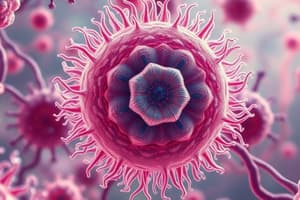Podcast
Questions and Answers
Which of the following statements accurately describes the differences between eukaryotic and prokaryotic cells?
Which of the following statements accurately describes the differences between eukaryotic and prokaryotic cells?
- Eukaryotic cells possess a nucleus, whereas prokaryotic cells lack a true nucleus. (correct)
- Prokaryotic cells have membrane-bound organelles, while eukaryotic cells do not.
- Prokaryotic cells contain multiple chromosomes, while eukaryotic cells have a single circular chromosome.
- Eukaryotic cells are generally smaller in size compared to prokaryotic cells.
What is the primary function of enzymes in biological processes?
What is the primary function of enzymes in biological processes?
- To serve as energy storage molecules.
- To act as hormones that regulate metabolic pathways.
- To increase the rate of chemical reactions. (correct)
- To provide structural support to cells.
In the fluid mosaic model, which component is primarily responsible for creating a semi-permeable membrane?
In the fluid mosaic model, which component is primarily responsible for creating a semi-permeable membrane?
- Cholesterol.
- Carbohydrates.
- Phospholipids. (correct)
- Proteins.
Which term describes organisms that can produce their own food using sunlight or chemical energy?
Which term describes organisms that can produce their own food using sunlight or chemical energy?
Which type of selection is characterized by extreme traits being favored over intermediate ones?
Which type of selection is characterized by extreme traits being favored over intermediate ones?
Flashcards are hidden until you start studying
Study Notes
Module 1: Cell Biology
- Distinguish between animal and plant cells: animal cells lack cell walls and chloroplasts, while plant cells have a rigid cell wall and are typically larger.
- Eukaryotic cells possess a nucleus and membrane-bound organelles; prokaryotic cells do not have a true nucleus and are usually unicellular.
- Magnification involves calculating the ratio of the image size to the actual size of the specimen.
- Surface area-to-volume ratio is critical for cell efficiency, affecting nutrient uptake and waste elimination.
- Enzymes are biological catalysts that speed up reactions and are affected by temperature, pH, and substrate concentration.
- The fluid mosaic model describes the structure of cell membranes, comprising a phospholipid bilayer with embedded proteins.
- Semi-permeable membranes allow selective movement of substances; diffusion and osmosis are key processes in substance transport.
- Hypertonic solutions have a higher solute concentration compared to cells, isotonic solutions are equal, and hypotonic solutions have a lower concentration.
- Understanding the impact of temperature, substrate concentration, and pH on enzyme activity is crucial for determining optimum and maximum ranges.
Module 2: Photosynthesis and Systems
- Photosynthesis consists of light-dependent reactions occurring in thylakoid membranes and light-independent reactions (Calvin cycle) happening in the stroma.
- Autotrophs (like plants) produce their own food via photosynthesis, while heterotrophs (like animals) depend on consuming other organisms.
- Identification of plant parts (like leaves and roots) and animal structures is vital for understanding their functions.
- Mastery of graphical representation, including drawing lines of best fit, is important for data analysis.
- There are distinct biological systems between plants (e.g., photosynthetic) and animals (e.g., respiratory).
- Human body cells exhibit specialization, with specific cells designed for particular functions.
Module 3: Evolution
- Convergent evolution occurs when unrelated species evolve similar traits; divergent evolution happens when related species develop different traits.
- The theory of evolution explains the gradual change in species over time through processes like natural selection.
- Evidence of evolution includes fossil records, genetic similarities, and geographical distribution of species.
- Microevolution refers to small-scale changes within a species; macroevolution encompasses broader changes that can result in new species.
- Gradualism posits that evolution occurs slowly and continuously; punctuated equilibrium suggests that evolution is marked by rapid changes followed by periods of stability.
- Ability to read and interpret food webs and food chains reflects understanding of ecological relationships, using examples like prickly pear and cane toad.
- Techniques like quadrat sampling, transect studies, and capture-recapture methods aid in studying biodiversity and species distribution.
- Speciation is the formation of new and distinct species, influenced by evolutionary traits accumulating over time.
- Comparative embryology, anatomy, and genomics provide insights into evolutionary relationships among species.
Module 4: Ecology
- Comprehension of food webs and chains illustrates energy flow and connections among organisms in an ecosystem.
- Understanding layers and types of predation (who eats whom) helps in analyzing ecological interactions.
- Ecological niches define how species interact with their environment, including their role in food webs.
- Resource partitioning allows different species to coexist by exploiting different resources or habitats to reduce competition.
- Selection pressures are environmental factors that influence the survival and reproduction of organisms, shaping evolution.
- Natural selection is a mechanism by which advantageous traits become more common in a population.
- Distinction between abiotic (non-living) and biotic (living) factors allows for a deeper understanding of ecosystems.
- Ecological interactions can be intraspecific (between the same species) or interspecific (between different species).
- Familiarity with various sampling techniques is crucial for gathering ecological data effectively.
Studying That Suits You
Use AI to generate personalized quizzes and flashcards to suit your learning preferences.




